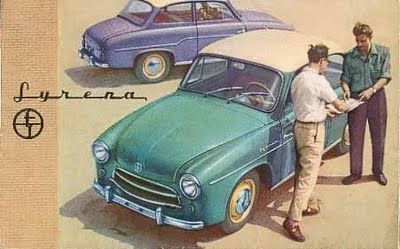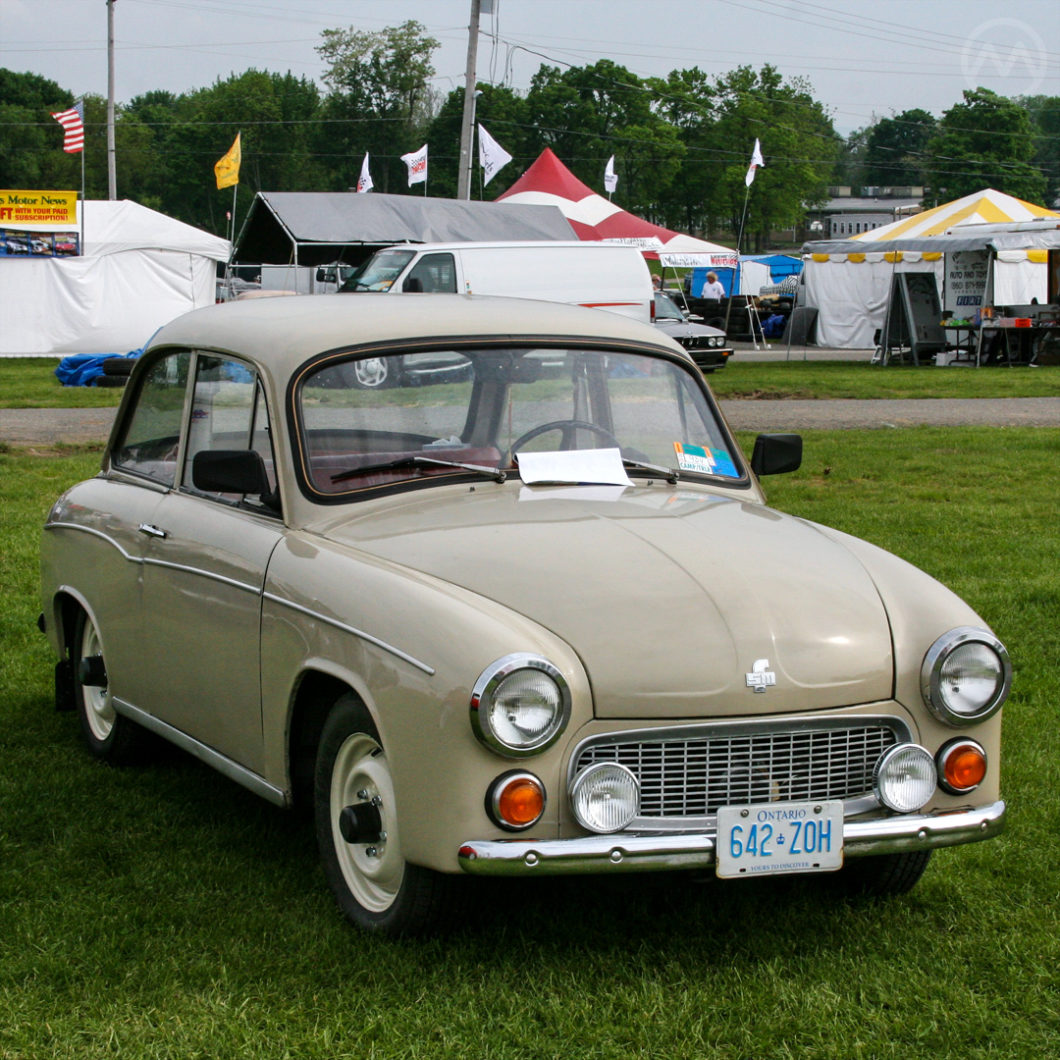A throwback today to car shows past today and 2009. This looks like a car of the 1950s, but this particular car was produced from 1972 to 1983. It’s a 1974 FSM Syrena 106, built in the Silesian city of Bielsko-Biała, Poland.
Of course, it looks like the 50s because the Fabryka Samochodów Osobowych (FSO) Syrena was designed in 1953. It was first shown to the public two years later, and entered production in Warsaw in 1957.
The Origins of FSO/FSM
FSO’s first product, the 1951 Warszawa, was a licensed version of the Russian GAZ Pobeda, a big car that looked a little like a mid-1940s Ford fastback sedan.
With components gradually sourced from within Poland rather than Russia, the Warszawa long outlived its Russian ancestor. It was lightly restyled by Ghia in 1964 and lasted in production until 1973, eventually even being exported to several Western European countries. It was a cheap car in the west, but very expensive at home.
Wanting to put more people on wheels, the Zawadzki Government approved a project for a mass-market car FSO had been tinkering with in early 1953. That car became the Syrena (Polish for “Siren,” as in the mermaid in Warsaw’s coat of arms), Poland’s own people’s car.
Two prototypes were put together in 1953, both sourcing some components from the Warsawa but one of them actually using whole body panels. The smaller and sleeker of the two, which used a wood frame, got the nod and the car first appeared at the 1955 Poznan trade fair.
By 1957, the car was in production, though it was very slow going at first, with early bodies made by hand.

The original Syrena 100 was a fairly advanced car for the mid-1950s – a front-driver powered by a punchy 746-cc 2-stroke twin designed by Fryderyk Bleumke mated to a 4-speeder, it wasn’t so different from a DKW or Saab of that time and the styling, by Stanislaw Panczakiewicz and Stanislaw Lucaszewicz, was very contemporary.
The only catch to the original Syrena was that to save costs, it had to use some components from the much larger Warszawa as on the two original prototypes. That made it a relatively hefty machine for a 2-cylinder small car. It weighed about 2,100 lbs., about what a Saab 96 weighed, but it was down a cylinder and made only 25hp.
Syrena Evolution
True volume production began with the Syrena 101 in 1960. In that decade the Syrena 101-104 series were gradually refined and given 3-cyl engines, at first borrowed from the East German Wartburg and later an in-house design mated to an all-synchro 4-speed.
That made for appreciably better performance (though the Syrena was never a road-burner); and there were handling, styling, and electrical upgrades too. By 1963 about 8,000 cars a year were being built, and by 1970 a major restyling of the Syrena was being considered.
In the meantime came Fiat.
With no replacements for the Warszawa or Syrena on the horizon, FSO began building licensed Fiats in 1967, starting with the 125P (later the basis of the FSO Polonez) and, more famously, the Fiat 126 – which in time largely supplanted the Syrena on the road in Poland.
The Syrena was an old car by then despite the many updates over the years, and the successive governments under Edward Ochab, Marian Spchalski, and Józef Cyrankiewicz all favored investing in Fiat’s tie-ups, which promised far more export potential than the old Warsawa.
The Syrena was never seen outside of Poland unless an individual person drove one out of the country. None were ever officially exported. But a Fiat built in Poland could be exported anywhere and bring home valuable cash while providing more jobs.
Increased 125P production – the cars were valuable to FSO as exports – saw the Syrena move to Bielsko-Biała in 1973, where it shared the factory floor with the 126P “Maluch.” The new facility was called Fabryka Samochodów Małolitrażowych – FSM, and the label on the Syrena was changed to match.
The 105 was the final version of the car, with all of the 1960s refinements and the 843-cc 2-stroke triple; and it continued more or less unchanged into April 1983. Van and pickup version, very popular with farmers and tradesmen in Poland, arrived just before the factory switch in 1972.
The Syrena in Post-Communist Poland
The Syrena 105 continued in production until 1983. The Pickup and Van were the first to be dropped in April, then the regular cars in June.
At the time, the previous three years in Poland had been ones of political and economic tumult, with the government clashing with the reform-minded “Solidarity” movement amid a sagging economy. Eventually, the Solidarity movement would establish a more democratic Poland and a market economy – in which Fiat eventually bought out FSM in 1992.
Many of the older vehicles in the former Eastern Bloc were largely unwanted in the 1990s – but the Syrena was a well-loved icon in Poland and soon had a following as a classic amid a flood tide of used cars from the west. Over 520,000 Syrenas were made during its long run – about 177,000 from FSO and another 344,000 from FSM.
The car is still a familiar sight in Poland, but not in North America. This car may be the only one in the U.S. or Canada.
The Syrena is largely unknown outside of Poland (and Eastern bloc car nerds), so demand for exports to other places has historically been low (except for Polish Expats). This one was imported to Canada by Slawek C. in the mid-2000s.


I’ve learnt how to drive in late 60-th over the rule of Syrena model 103 (30 HP engine); now, after all over of those 2,5 mln kilometers I made driving various cars within my life, I must remind it to everyone – Syrena was the most beautiful, friendly and dilligent among cars I ever was sitting in…
I’d do much to be able to come back to this car, to own it again and to meeting it everyday when planning to go anywhere anytime…
Syrena was a song of the classic Gran Turismo times, when people use cars for enjoying their freedom, not only for impressing others, like today…